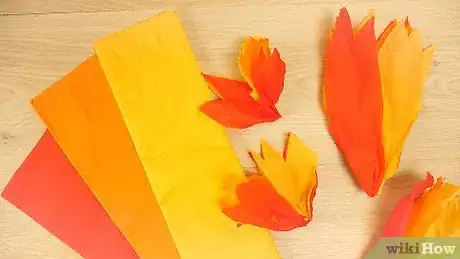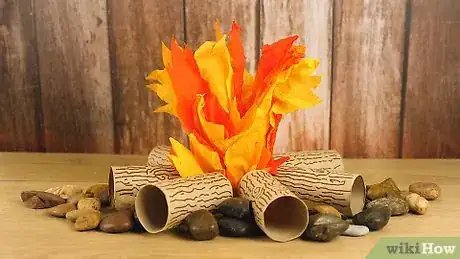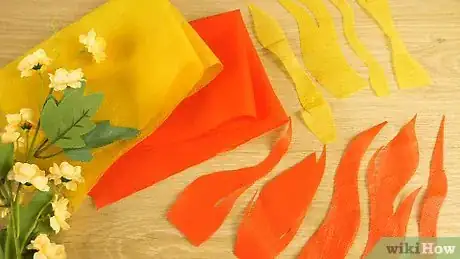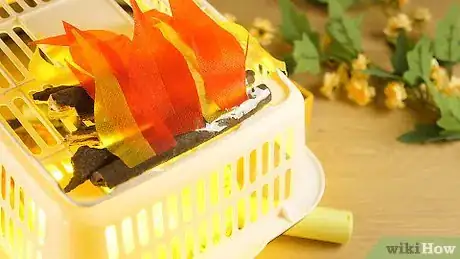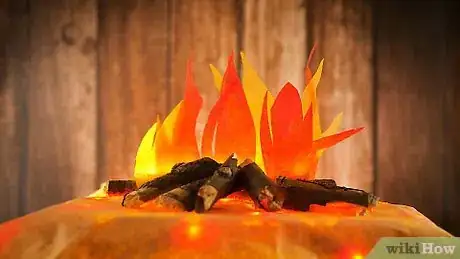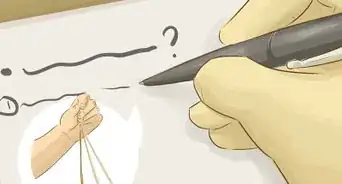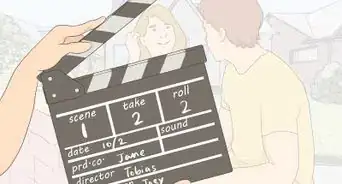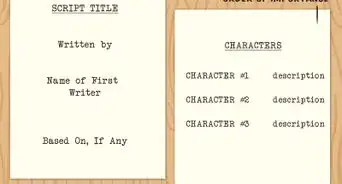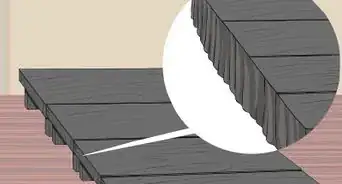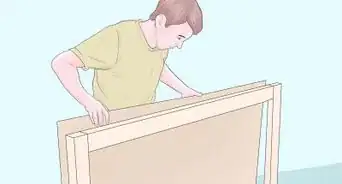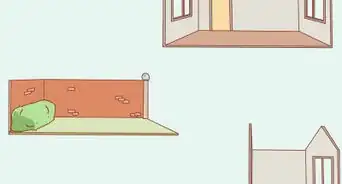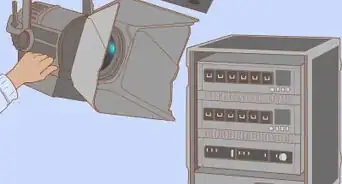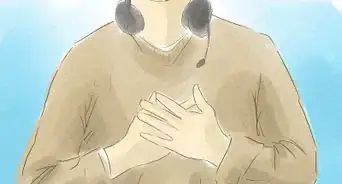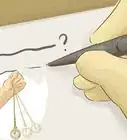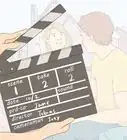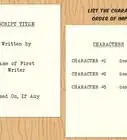wikiHow is a “wiki,” similar to Wikipedia, which means that many of our articles are co-written by multiple authors. To create this article, 33 people, some anonymous, worked to edit and improve it over time.
The wikiHow Video Team also followed the article's instructions and verified that they work.
This article has been viewed 388,862 times.
Learn more...
There's nothing quite like the gentle, warm crackle of a real fire. Unfortunately, there are many places where open flames are inappropriate or unsafe - for instance, during a stage production or at an indoor party. For these situations, fake yet realistic prop flames can create the atmosphere of a real fire without the risk.
Steps
Quick Tissue and Flashlight Method
-
1Make tissue flames. You can arrange your flame-colored tissue paper in any way you see fit to make flames. When you're done, use a hot glue gun to stick your individual flames together into one multi-colored bonfire.[1] One quick, easy way to create tissue flames that gives great results is as follows:
- Lay a fresh sheet of tissue paper on a table before you. Pinch it gently in its center. Holding on to the sheet, whip your hand up quickly and gently catch the tissue paper. The force of pulling the tissue through the air should shape your tissue paper into a flame or bouquet shape. Handle it gently - it's easy to deform.
-
2Make logs from paper towel rolls. Use a sharpie to make wood grain lines on several paper towel rolls or toilet tissue rolls. You may want to cut longer rolls in half so that your logs are similarly-sized.[2]
- If you have time, as an extra touch, try lightly soaking the paper towel rolls in water, crushing them in your hand, and allowing them to dry before drawing wood grain lines on them. This will give them a wrinkled, realistic appearance, mirroring real logs.
Advertisement -
3Glue your logs and flames together. Now that you have flames and logs, it's time to build a campfire. Arrange your logs in a way that looks like a real campfire - for instance, you may choose to have them lying in a loose pile or leaning against one another in a pyramid-like arrangement. Glue your logs securely in place with a hot glue gun. Next, glue your flames in place. For a realistic appearance, have some flames on top of the pile of logs with others emerging from the sides, as in a real fire.[3]
-
4Add fake rocks (optional). As an added decoration, you may want to add grey coals or rocks in and around your campfire. Doing this is easy - all you need to do is paint styrofoam packing peanuts grey (spray paint is cheap, easy, and works well). For bigger rocks, cut or break chunks from styrofoam packing material.
-
5Shine a flashlight behind your flames. Putting a small, well-concealed flashlight behind your fire is a great way to give it a flaming glow. Prop a small, medium-intensity flashlight so that it shines up into the base of the flames. Done correctly, this will make the flames at the base of the fire brightest, giving the impression that the fire is glowing with intensity.
- You may find that conventional bulbs give a better effect than LED bulbs. LED bulbs usually give off a "white" light and can be quite bright, while conventional bulbs can have a warmer, slightly dimmer, more natural "yellow" glow.
-
6Set up a fan behind your fire (optional). If you have space, a small, gentle fan can give your flames a constant rustling motion, mimicking the effect of real flames. If you can, have the fan blow up directly behind the fire; otherwise, set the fan at its lowest setting a few feet behind the fire. The flames shouldn't drastically bend or sway - you're looking for a gentle, subtle effect that's not too distracting.
-
7Finished.
Fabric and Fan Method
-
1Cut your "flames." In this method, we use the airflow from a fan to cause a fake fabric "flame" to billow and blow. The size of your flame will depend on the desired size of your fake fire or the space limitations of your fireplace. Taking these measures into account, cut flames accordingly.[4]
- When it comes to cutting flames, you have several options. You may want to cut many thin strands of fabric to give your fire a thin, "wisp-y" appearance, or, alternatively, you may want to cut a flat flame-shaped sheet for a more robust look. You can even create a 3-dimensional flame by using a tented piece of fabric open at the bottom -- however, if you do this, be sure to cut several holes at the top for the air to pass through or you'll have a "fat", stationary flame.
-
2Attach your flames to dowels. The base of each fabric flame should be secured to a wooden dowel to keep the flame in place while allowing it to blow freely. Take each flame you've cut and attach its "bottom" to a dowel with a staple, tape, or other method that allows the rest of the flame to move freely. You may attach all your flames to one dowel, but for a more impressive, staggered effect, use several different dowels.
- If you're using the "tented" flame described above, attach each side of its open bottom to two dowels so that its bottom is held slightly open. This allows air to flow through, inflating the flame.
- Note - to be clear, flames should be attached to the long, round side of a dowel - not either end.
-
3Arrange your dowels in the location you want your fire. Lay the ends of the flame dowels across cross pieces in your fireplace grate or across the top of a basket or coffee can, etc. Set your dowels so that they're spanning the space directly above where you want your fan to be. The dowels should run parallel to each other so that they present the wide face of each flame to the audience.
-
4Place your fan under the flame. Arrange your fan underneath your flames so that it blows "up" through them. If you're using a fireplace grate, this means putting the fan right underneath it. If you're using a basket, put the fan face-up at the bottom of the basket. If you're using a coffee can or other similar container, you may need to carefully cut the bottom out and secure the fan so that it blows up through the hole.[5]
- You may find that it's easiest to put your fake fire directly in front of an electrical outlet so that the fan's cord can't be seen stretching across the floor.
-
5Place your light source(s) under the flame dowels. Arrange red, orange, and/or yellow colored lights under your flames so that their light shines directly up into them. Theater rental companies should have colored lights available, but you may find it easier to simply shine normal flashlights through colored glass or cellophane.
-
6Test your flame. Before you finalize the arrangement of your flames, lights, and fan, it's smart to give them a test drive. If you can, dim the lights in the room, then turn on the colored lights and blower. If everything's working correctly, your flame should billow realistically, illuminated from below. If it doesn't, make adjustments as necessary and test again.
-
7Conceal your fan and lights. Now that you know your fire works as intended, it's time to give it the appearance of a real fire instead of a fan-powered contraption. For instance, you might try placing logs over and around the flames. You might also want to spread fake ashes and burnt debris over and around the fire.
- If you don't have real logs at your disposal, don't worry - you can make fake lightweight logs by cutting pool noodles into short sections and wrapping these in construction paper.
- Another good idea is to mimic the appearance of "coals" by piling a string of LED or Christmas-style lights beneath the fire. The effect is best if you can find red or orange lights or if you put a layer of red or orange cellophane over the lights.[6]
Community Q&A
-
QuestionWhat kind of LED lights am I looking for? Just standard colored light bulbs that I could plug into any lamp in my house?
 Community AnswerLook for a very small one that is soft white or even a yellow bug bulb but check that the socket it screws into has the correct base. LED won't save you anything since the flame doesn't need much light. Ask at your local home improvement store.
Community AnswerLook for a very small one that is soft white or even a yellow bug bulb but check that the socket it screws into has the correct base. LED won't save you anything since the flame doesn't need much light. Ask at your local home improvement store. -
QuestionInstead of using a hot glue gun, what can I use?
 LaylalovesdogsCommunity AnswerYou could try Gorilla glue or just basic Elmer's glue, but the hot glue helps it to be more stable and stick longer.
LaylalovesdogsCommunity AnswerYou could try Gorilla glue or just basic Elmer's glue, but the hot glue helps it to be more stable and stick longer. -
QuestionMy friends and I are using cardboard logs for the fire. Is that okay to do?
 Community AnswerAs long as it's not a real fire and the logs aren't too close to the light.
Community AnswerAs long as it's not a real fire and the logs aren't too close to the light.
Warnings
- Never use paper logs for a real fire.⧼thumbs_response⧽
- Careful when cutting.⧼thumbs_response⧽
Things You'll Need
For the Fabric and Fan method:
- Thin, tightly woven white fabric. Silk, rayon, nylon, and polyester work fine.
- Logs. Can be real or fake (see below).
- A non-rotary blade type fan. A "forward curve" blower (also known as a "squirrel cage" blower) works best, as it runs the quietest.
- Flame-colored lights. You can use genuine colored lights or just shine normal flashlights through colored glass or cellophane.
- Thin wooden dowels or similar-sized objects. Half-inch dowels work well.
- Flame-colored cellophane (optional). See above.
- Light strips (optional). Christmas-style light strings work fine, as do modern LED strips.
- Fireplace grate (optional). Helpful for a realistic look and to hold up heavy logs if you're using real ones.
- Basket, coffee can or similarly sized container (optional). Useful for containing/concealing the fan and making the fake fire portable.
For the Quick Tissue and Flashlight method:
- Multiple sheets of flame-colored tissue paper - reds, oranges, and yellows are best.
- Paper towel rolls or toilet paper rolls - one or two paper towel rolls (or about 4 toilet paper rolls) is enough.
- Sharpie
- Flashlight
- Hot glue gun.
- Electric fan (optional). The smaller the better.
- Styrofoam packing peanuts (optional).
- Gray paint (optional).
References
- ↑ http://aboutfamilycrafts.com/how-to-build-a-campfire/
- ↑ https://www.dltk-kids.com/scouts/mcampfiretp.htm
- ↑ https://www.dltk-kids.com/scouts/mcampfiretp.htm
- ↑ https://www.hauntforum.com/showthread.php?t=15113
- ↑ https://www.hauntforum.com/showthread.php?t=15113
- ↑ https://www.hauntforum.com/showthread.php?t=15113
About This Article
To make a fake fire, start by cutting red and yellow sheets of tissue paper into flame shapes, then stick them together using a glue gun. Next, draw wood grain lines on paper towel rolls with a sharpie to create logs. Glue the flames and logs together with the glue gun, then make rocks to go around the fire by breaking off pieces of styrofoam and painting them gray. Finally, position a flashlight behind your fire to make it look like it's burning and set up a fan to blow air on it so the flames move. To learn how to make a fire using fabric and a fan, read on!
